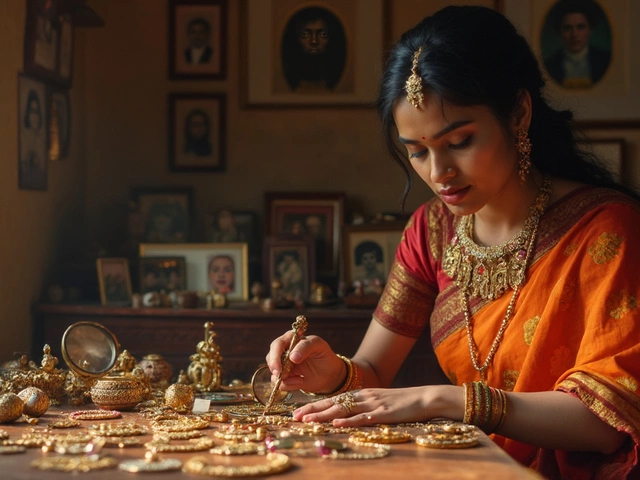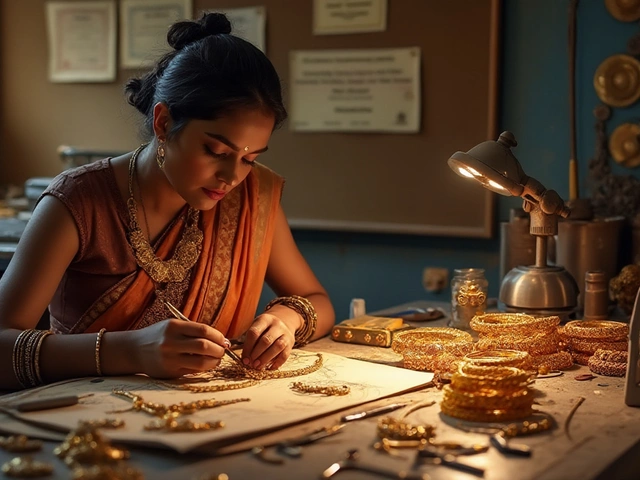Sacred Symbol in Indian Jewellery: What It Means and How to Wear It
If you’ve ever wondered why some pieces feel more than just decorative, you’re not alone. In India, many jewellery items carry a story, a ritual, or a belief that goes back generations. These sacred symbols aren’t just pretty – they’re a way to connect with culture, protect the wearer, or mark a life event.
From the bold black bangles on a bride’s wrist to the tiny nose stud that signals tradition, each symbol has a clear purpose. By understanding the meaning, you can pick pieces that fit both your style and the story you want to tell.
Common Sacred Symbols and Their Stories
Black Bangles: Black bangles are more than a fashion statement. They’re believed to ward off the evil eye and bring strength. Many families pass them down, and they’re often worn during festivals or important ceremonies.
Black Beads in Mangalsutra: A mangalsutra is the marriage necklace many Indian brides wear. The black bead, usually placed near the clasp, represents protection and the bond that holds the couple together. It’s a tiny but powerful part of the design.
Nose Studs: Nose piercings have deep religious roots, especially in Hindu culture. They’re linked to the goddess Parvati and are thought to enhance a woman’s health and fertility. Modern designs keep the tradition alive while fitting today’s trends.
Breaking Glass in Hindu Rituals: You might have seen a glass bottle smashed during a wedding. It’s a symbolic act that drives away negative energy and invites fresh beginnings. Some people keep a small piece of that broken glass as a lucky charm.
Hallmarks like 875 on Gold: While not a visual symbol, the 875 stamp tells you the gold is 21‑carat, pure enough for sacred items. Knowing the hallmark helps you trust the piece’s authenticity, which is crucial for heirloom jewelry.
How to Choose and Wear Sacred Symbols Today
Start with what matters to you. If protection is a priority, look for black bangles or a mangalsutra with a solid black bead. If you love heritage, pick a nose stud in a classic design – a simple gold hoop works everywhere.
Check the craftsmanship. Authentic symbols often have clear hallmarks, a reliable weight, and sturdy settings. A quick magnet test can tell you if a piece is truly gold and not just plated.
Mix old and new. Pair a traditional black bangle with a modern cuff, or wear a vintage mangalsutra alongside contemporary earrings. The contrast keeps the look fresh while honoring the story.
Think about when you’ll wear it. Some symbols, like black bangles, are perfect for festivals and weddings. Others, such as a subtle nose stud, can be everyday wear. Choose pieces that fit the occasions you plan for.
Finally, treat these items with care. Clean gold with a soft cloth, store black bangles separately to avoid scratches, and keep any hallmarked pieces in a safe box. When you maintain them, the symbols stay strong for the next generation.
Whether you’re buying your first piece or adding to an existing collection, knowing the meaning behind each sacred symbol makes the jewelry more personal. Use these tips to pick items that look great, feel right, and keep the tradition alive.
Kirpan: More Than Just a Sword – A Sacred Duty
Kirpan, a ceremonial dagger in Sikhism, transcends its physical form to embody a powerful religious duty. While often mistaken as just a weapon, the Kirpan symbolizes deep-rooted values of courage, self-sacrifice, and protection of the weak. This article explores the significance, history, and modern-day challenges surrounding the Kirpan. By understanding its true essence, one gains insight into a pivotal element of Sikh identity and spirituality.





